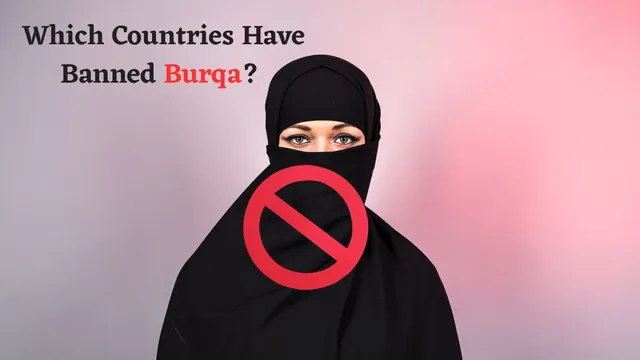- By Aditi Priya Singh
- Wed, 02 Jul 2025 06:02 PM (IST)
- Source:JND
20+ Countries That Have Banned Burqa: In recent years, many nations around the world have introduced a law on the prohibition of burqas and other face-covering veils in public settings. Many countries with a majority of Muslims have also implemented restrictions for a variety of reasons, so these prohibitions are not just found in Western countries. Some governments claim the ban protects secular values or combats religious extremism, while others say it enhances social integration, aids in identification, and increases public safety.
In countries like France, Belgium, Denmark and Switzerland, the burqa ban is tied to national values such as secularism, gender equality, open communication, and public safety. These countries believe that hiding one’s face in public can lead to problems in identification, security, and social integration. They also argue that such attire limits women's freedom and goes against the idea of an open and equal society.
Interestingly, some Muslim-majority countries like Morocco, Tunisia, Egypt, and Algeria have also enforced burqa bans, particularly in schools, universities, and government offices. These measures are often taken to support secular education, promote national dress, or prevent religious extremism. The bans are usually partial and focus on specific areas like public offices or educational institutions, rather than a complete nationwide restriction.
List of 20+ Countries That Have Banned the Burqa
This list includes more than 20 countries from Europe, Africa and the Islamic world, each with its reasons and timeline for imposing restrictions. Let’s explore which nations have taken this step, what was banned, and why these decisions were made.
| Country | Year Of Ban | What Was Banned | Reason for Ban |
| Belgium | 2011 | Full face coverings | Women's equality and security |
| Bulgaria | 2016 | Face veils in public institutions | National identity and safety |
| Austria | 2017 | Face coverings in public spaces | Open communication and safety |
| Denmark | 2018 | Burqa, niqab in public | Open communication and integration |
| France | 2011 | Face veils in all public places | Secularism, women's rights, security |
| Latvia | 2016 | Face coverings in public | Public identity and cultural integration |
| Netherlands | 2019 | Face coverings in govt buildings, schools, and transport | Communication and safety |
| Norway | 2018 | Face coverings in educational institutions | Learning environment and interaction |
| Russia | 2012 | Face veils in schools and offices | Uniformity and public service norms |
| Switzerland | 2021 | Full face coverings in public | National identity and women's freedom |
| Sweden | 2019 (No full ban) | Institutional restrictions | Safety and communication |
| Muslim Countries | |||
| Algeria | 2018 | Face veils for public workers | Identification and workplace standards |
| Egypt | 2015 | Burqas in universities | Communication and identification |
| Kyrgyzstan | 2024 (No full ban) | Discouragement, partial restrictions | Radicalisation and cultural identity |
| Morocco | 2017 | Sale and production of burqas | Security concerns |
| Syria | 2010 | Niqab in educational institutions | Secularism and extremism prevention |
| Tajikistan | 2017 | Islamic veils in public service | Cultural identity enforcement |
| Tunisia | 2019 | Niqab in government buildings | Facial identification and security |
| Uzbekistan | 2018 | Religious wear in schools/government | Secularism and policy pressure |
| African Countries | |||
| Cameroon | 2015 | Burqa in northern regions | Security after bomb attacks |
| Chad | 2015 | Full-face veils in public | Security and terrorism prevention |
| Gabon | 2015 | Burqa in schools and government buildings | Identification and secular values |
| Republic Of Congo | 2015 | Burqa in institutions and schools | National security and order |
Countries With a Partial Ban On Burqa
Some countries have enforced a partial ban on the burqa, meaning restrictions apply only in certain places like government offices, schools, or during public services. Nations such as Canada, China, Sri Lanka, Myanmar, and Australia have limited burqa use mainly for security, identification, and communication in official or sensitive settings.
| Australia | Varies by state (2014–2020) | Face coverings in courts, public buildings (in some states) | Identification, security, and courtroom decorum |
| China | 2015 | Burqa banned in Xinjiang region | Counter-terrorism and promoting cultural assimilation |
| Myanmar | 2017 (Rakhine State) | Face veils in some conflict zones | Security and ethnic tensions |
| Sri Lanka | 2019 | Face coverings banned after Easter bombings | National security and preventing terrorism |
| Canada | 2019 (Quebec) | Face coverings in public services (Bill 21) | Secularism and open communication in civic services |
Burqa Ban In India
In India, there is currently no nationwide ban on the burqa. Women are free to wear religious or cultural clothing like the burqa or hijab in most public places. However, some restrictions have been seen in schools, colleges, or exams, where authorities ask for proper identification for security or uniform policies. In states like Karnataka, debates have taken place over wearing hijabs in educational institutions, which led to court cases and temporary bans in certain colleges.
These decisions are usually made by state governments or specific institutions, not the central government. India’s Constitution gives people the right to religious freedom, but it also allows authorities to make rules for public order and safety. So, while there is no official ban on the burqa in India, local rules and discussions continue depending on the situation and place.

